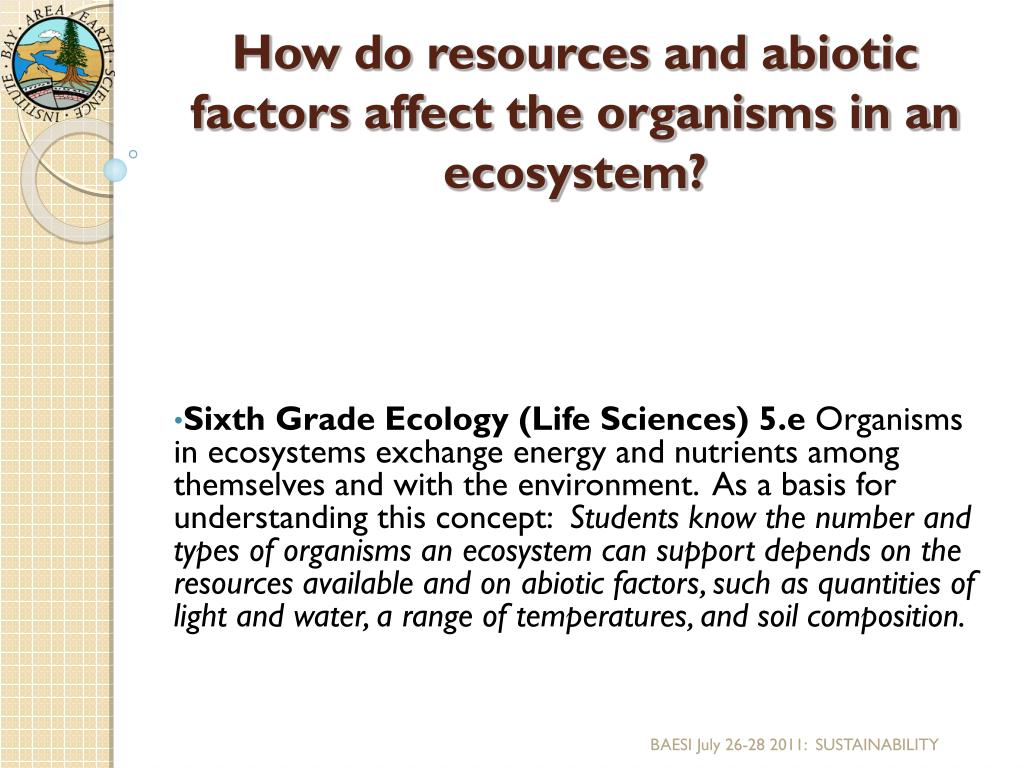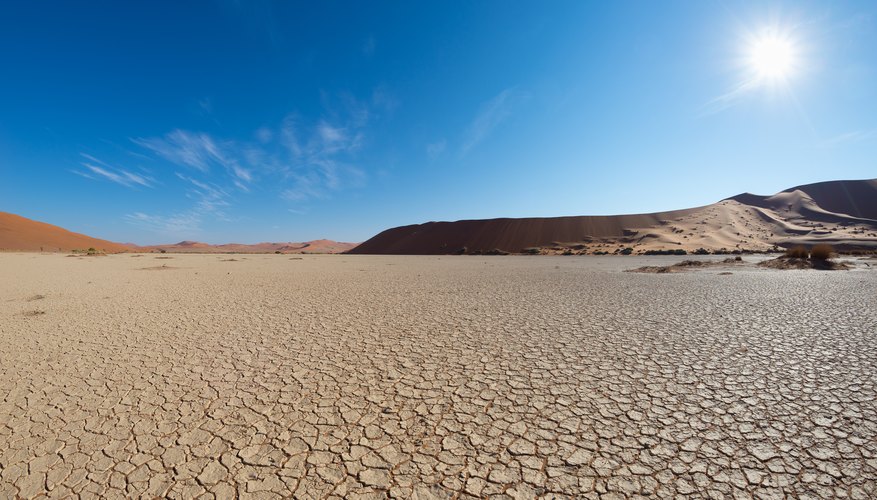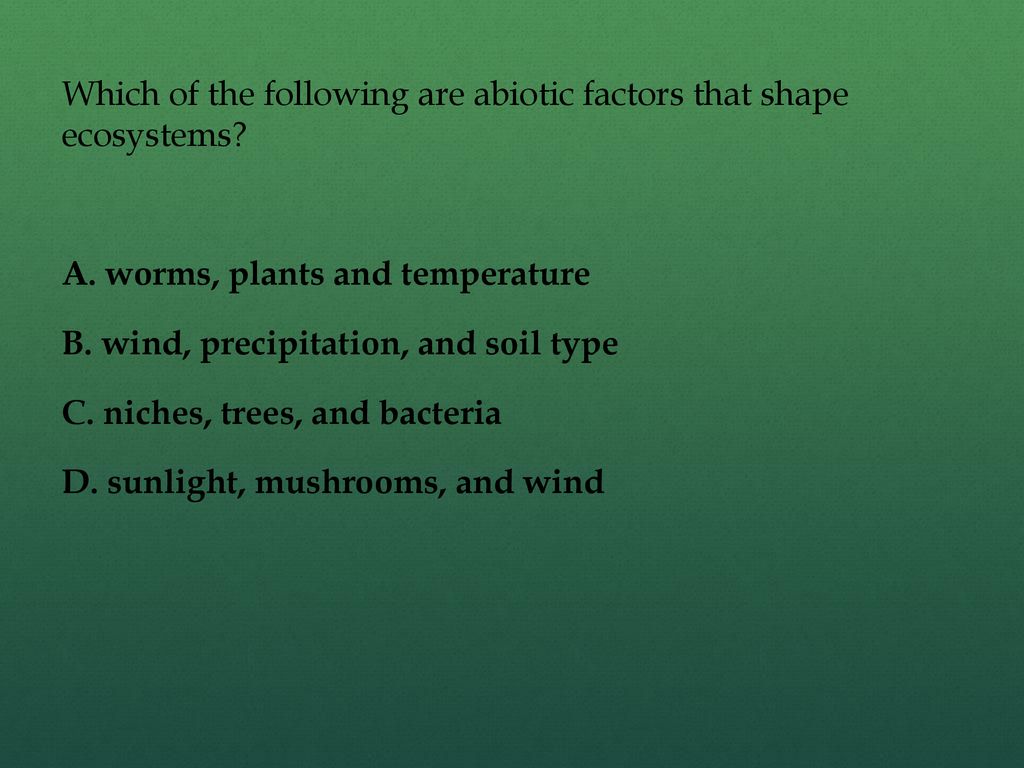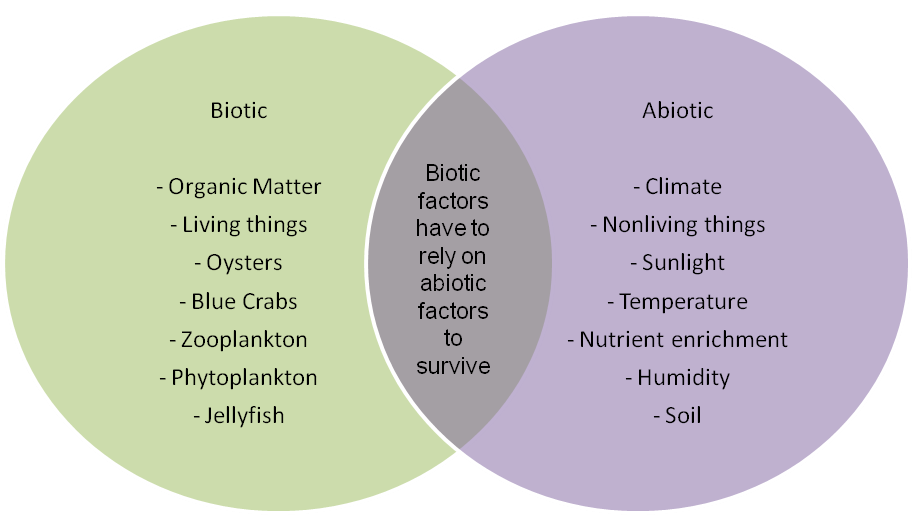Topic how do abiotic factors affect organisms in an ecosystem: Explore the fascinating dynamics of ecosystems as we delve into how abiotic factors crucially influence the lives of organisms, shaping biodiversity and ecological balance.
Table of Content
- How do abiotic factors impact organisms in an ecosystem?
- Understanding Abiotic Factors and Their Impact on Ecosystems
- Key Abiotic Factors Influencing Ecosystem Dynamics
- Temperature"s Role in Ecosystem Health and Species Distribution
- Water Availability and Its Effects on Living Organisms
- Light Intensity and Photoperiodism in Plant and Animal Life
- Soil Composition and Structure Affecting Flora and Fauna
- YOUTUBE: Abiotic Factors in Ecosystems: Water
- Atmospheric Gases and Their Influence on Ecosystem Functioning
- Wind Effects on Plant Growth and Animal Habitats
- Salinity Levels in Aquatic Ecosystems and Their Biological Impact
- pH Levels of Soil and Water Bodies Shaping Biotic Communities
- Human Impacts on Abiotic Factors and Ecosystem Health
- Adaptation Strategies of Organisms to Abiotic Stress
- The Interplay Between Abiotic and Biotic Factors in Ecosystems
How do abiotic factors impact organisms in an ecosystem?
Abiotic factors are non-living components of an ecosystem that play a crucial role in shaping the environment and influencing the organisms within it. These factors can have both direct and indirect impacts on organisms, often determining their ability to survive, reproduce, and thrive in a given ecosystem.
Here are some ways in which abiotic factors can impact organisms in an ecosystem:
- Temperature: Temperature influences the metabolic rates and physiological functions of organisms. Different species have specific temperature requirements, and changes in temperature can affect their behavior, growth, reproduction, and overall survival. Extreme temperatures can be particularly detrimental, causing heat stress or frost damage.
- Light: Light availability plays a vital role in photosynthesis, the process by which plants and other photosynthetic organisms convert sunlight into energy. Different organisms have varying light requirements, and changes in light intensity or quality can influence their growth patterns, flowering cycles, and distribution within the ecosystem.
- Water: Water availability and quality are crucial for the survival of organisms. Some species are adapted to arid environments and can withstand limited water supplies, while others require constant access to water. Changes in water availability, such as droughts or floods, can impact the distribution and abundance of organisms and may lead to competition for limited resources.
- Air and Atmospheric Conditions: Atmospheric factors such as oxygen, carbon dioxide, and other gases can directly affect the respiratory capacities of organisms. Additionally, air pollutants or changes in atmospheric composition can have detrimental effects on the health and survival of organisms.
- Soil Composition: The physical and chemical properties of soil are key abiotic factors that influence the types of plants and microorganisms that can thrive in an ecosystem. Soil pH, nutrient availability, and texture can significantly impact plant growth, root development, and nutrient uptake by organisms.
- Topography and Geology: The physical features of an ecosystem, such as mountains, valleys, and soil erosion patterns, can create diverse habitats and influence the distribution and movement of organisms. Geological factors, such as the presence of rock formations or mineral deposits, can also affect the availability of certain nutrients.
Overall, abiotic factors act as fundamental building blocks for an ecosystem and directly or indirectly impact the organisms living within it. Understanding these factors and their effects plays a crucial role in managing and conserving ecosystems and the biodiversity they support.
READ MORE:
Understanding Abiotic Factors and Their Impact on Ecosystems
Abiotic factors are the non-living components of the environment that play a critical role in shaping ecosystems. These elements influence the survival, growth, and reproduction of organisms, thereby determining the structure and function of ecosystems. Understanding these factors is essential for comprehending the complexity of ecological interactions and the maintenance of biodiversity.
- Temperature: Governs the metabolic rates of organisms and affects their geographical distribution.
- Light: Provides energy for photosynthesis, influencing plant growth and, indirectly, the availability of food for herbivores.
- Water: Essential for all life forms, its availability impacts the living conditions in an ecosystem.
- Soil: The composition and quality of soil affect the types of plants that can grow, which in turn supports various animal species.
- Atmospheric Gases: Oxygen, carbon dioxide, and nitrogen are crucial for life processes such as respiration and photosynthesis.
Each of these factors can vary in intensity and duration, leading to different responses from the organisms in an ecosystem. The interplay between abiotic factors and biotic factors (living components) shapes the habitat and ecological niches, promoting a diversity of life forms adapted to specific environmental conditions.
Key Abiotic Factors Influencing Ecosystem Dynamics
The dynamics of ecosystems are profoundly shaped by several key abiotic factors. These elements not only affect the physical environment but also influence the biological interactions within ecosystems. Understanding these factors is crucial for studying ecological balance and the health of various habitats.
- Temperature: Acts as a primary determinant of the types of organisms that can survive in an ecosystem. It affects biological processes and controls species distribution.
- Light: Essential for photosynthesis, light availability influences plant productivity and energy flow through an ecosystem.
- Water: Availability and quality of water determine the survival of aquatic and terrestrial life forms. It influences species composition and ecosystem productivity.
- Soil Quality: Influences the types of vegetation that can thrive, which in turn supports various animal communities through food webs.
- Wind: Affects plant morphology, seed dispersal, and microclimates within ecosystems. Wind patterns also influence weather conditions and climatic zones.
- Salinity: Especially crucial in aquatic ecosystems, salinity levels affect the distribution of marine and freshwater species.
- pH Levels: Soil and water pH can influence nutrient availability and toxicity, affecting plant growth and the types of microbial communities that can exist.
These abiotic factors interact in complex ways, influencing the resilience and stability of ecosystems. Changes in any of these factors can lead to shifts in ecosystem dynamics, demonstrating the interconnectedness of Earth"s systems.
Temperature"s Role in Ecosystem Health and Species Distribution
Temperature significantly influences ecosystem health and the distribution of species across different habitats. It affects physiological processes, behaviors, and survival strategies of organisms, shaping the biodiversity and structure of ecosystems.
- Physiological Impact: Temperature regulates metabolic rates in organisms. Warmer temperatures can increase metabolic activity, while colder temperatures reduce it.
- Behavioral Adaptations: Species adapt their behaviors to cope with temperature variations. Some migrate, hibernate, or alter their activity patterns to avoid extreme conditions.
- Reproductive Success: The fertility and reproductive cycles of many species are closely tied to temperature, affecting their breeding seasons and offspring survival rates.
- Species Distribution: Temperature gradients across latitudes and altitudes dictate the distribution of species. Each species has a thermal tolerance that determines its geographical range.
- Ecosystem Productivity: Temperature influences photosynthesis rates in plants and primary productivity, which in turn affects the entire food web.
The ongoing changes in global temperatures due to climate change are altering ecosystem dynamics, highlighting the critical role of temperature in environmental health and species conservation.

Water Availability and Its Effects on Living Organisms
Water is a fundamental abiotic factor that affects all aspects of life in an ecosystem. Its availability—or lack thereof—has profound impacts on the survival, distribution, and behavior of living organisms, shaping ecosystems at various scales.
- Essential for Life: Water is crucial for hydration, digestion, and nutrient transport in organisms. It is also indispensable for photosynthesis in plants.
- Habitat Formation: The presence of water bodies creates habitats for aquatic and semi-aquatic species. Wetlands, rivers, lakes, and oceans support diverse biological communities.
- Regulation of Body Temperature: Many organisms rely on water for thermoregulation, using it to cool down through processes like sweating or transpiration.
- Influence on Biodiversity: Areas with high water availability, such as tropical rainforests, tend to have higher biodiversity compared to arid regions.
- Impact on Migration Patterns: The seasonal availability of water can drive migration patterns of animals, especially in arid and semi-arid ecosystems.
Climate change and human activities are increasingly affecting water availability, leading to challenges like droughts, floods, and the alteration of aquatic ecosystems. Understanding the role of water in ecosystems is crucial for conservation efforts and sustainable management practices.
Light Intensity and Photoperiodism in Plant and Animal Life
Light, both in terms of intensity and photoperiod (day length), plays a crucial role in the regulation of many biological processes in plants and animals. Its influence extends across ecosystems, affecting growth patterns, behavior, and reproductive cycles.
- Photosynthesis: Light intensity directly impacts the rate of photosynthesis in plants, influencing growth, energy production, and oxygen release.
- Growth and Development: In plants, light regulates morphogenesis (development of form and structure), including stem elongation, leaf expansion, and flowering.
- Photoperiodism: The length of day and night triggers seasonal responses in both plants and animals, such as flowering in plants and breeding in animals.
- Behavioral Adaptations: Animals use light cues for navigation, foraging, and predator avoidance. Seasonal changes in light also affect migration patterns and hibernation.
- Ecological Interactions: Light availability influences the stratification of plant communities and the structure of food webs by determining which plants can grow in certain areas, subsequently supporting various animal species.
The changing patterns of light intensity and photoperiodism due to global climate change and human-induced habitat alterations are affecting ecosystems worldwide, highlighting the importance of understanding light"s ecological roles.

Soil Composition and Structure Affecting Flora and Fauna
Soil, with its complex composition and structure, is a fundamental abiotic factor that has a profound impact on the distribution and health of flora (plants) and fauna (animals). It serves as the foundation of terrestrial ecosystems, influencing water availability, nutrient cycles, and habitat quality.
- Nutrient Availability: The mineral content of soil determines its fertility, affecting the types and quantities of plants that can grow, which in turn supports various animal species.
- Water Retention: Soil structure influences its ability to hold water. Clay soils retain more water than sandy soils, affecting plant growth and water availability for animals.
- Aeration: The space between soil particles allows for air movement, which is crucial for root respiration and the activity of soil microorganisms, impacting plant health and soil fertility.
- pH Level: Soil pH affects the solubility of nutrients and can influence the types of plants that thrive, thereby shaping the habitat for animal species.
- Organic Matter: The amount of decomposed material in soil contributes to its nutrient richness, influencing plant diversity and the food resources available for fauna.
The interaction between soil characteristics and living organisms is a dynamic process. Changes in soil composition and structure due to natural processes or human activities can significantly impact ecosystem functions, highlighting the importance of soil conservation in ecological sustainability.
Abiotic Factors in Ecosystems: Water
Dive into the mesmerizing world of water and discover its endless wonders. Watch our captivating video as we explore crystal clear oceans, majestic waterfalls, and serene lakes that will leave you in awe of nature\'s beauty.
Abiotic Factors in Ecosystems: Temperature
Discover how temperature plays a vital role in our daily lives in this intriguing video. From the science behind weather patterns to the ways in which temperature affects our moods, this informative video will keep you engaged and fascinated.
Atmospheric Gases and Their Influence on Ecosystem Functioning
Atmospheric gases play a pivotal role in the functioning of ecosystems. They are crucial for life processes such as photosynthesis, respiration, and the regulation of Earth"s temperature. The composition and concentration of these gases can significantly influence ecosystem health and biodiversity.
- Oxygen: Essential for the respiration of most living organisms, oxygen supports aerobic life forms and influences energy production within ecosystems.
- Carbon Dioxide: A key component of photosynthesis, carbon dioxide levels affect plant growth rates and carbon sequestration capabilities, impacting food chains.
- Nitrogen: Although the majority of the atmosphere is nitrogen, it must be fixed into a usable form for most organisms. Nitrogen cycling is crucial for protein synthesis in plants and animals.
- Water Vapor: Influences weather patterns and climate, affecting ecosystem productivity and species distribution through precipitation levels.
- Methane and Other Trace Gases: Play roles in the greenhouse effect and climate change, affecting ecosystems indirectly through temperature and weather changes.
The balance of atmospheric gases is critical for maintaining the Earth"s climate and, consequently, the health of its ecosystems. Changes in the concentration of these gases, often due to human activities, pose challenges to ecosystem stability and biodiversity.
Wind Effects on Plant Growth and Animal Habitats
Wind is an abiotic factor with significant effects on the structure of plant communities and the habitats of animals. It influences pollination, seed dispersal, and the physical shaping of habitats, thereby affecting the distribution and behavior of both flora and fauna.
- Pollination: Wind assists in the pollination of many plant species, enabling the reproduction of both flowering plants and conifers.
- Seed Dispersal: Wind can carry seeds away from the parent plant to new locations, aiding in species spread and the colonization of new areas.
- Plant Morphology: Constant wind can lead to adaptations in plant structure, such as stunted growth and thicker leaves, to reduce damage and water loss.
- Microhabitats: Wind shapes landscapes, creating microhabitats by affecting temperature and moisture levels. Animals use these areas for shelter, nesting, and hunting.
- Animal Behavior: Wind influences the behavior of animals, affecting their movement, feeding patterns, and predator-prey interactions.
The interaction between wind and ecological components underscores the dynamic nature of ecosystems. Understanding wind"s role is essential for comprehending how abiotic factors influence biodiversity and ecosystem resilience.
Salinity Levels in Aquatic Ecosystems and Their Biological Impact
Salinity, the concentration of salts in water, is a crucial abiotic factor in aquatic ecosystems, significantly influencing the life processes and distribution of aquatic organisms. It affects the osmoregulation mechanisms of aquatic species and can lead to varied biodiversity within different salinity regimes.
- Osmoregulation: Aquatic organisms have adapted to maintain internal salt concentrations, critical for survival in either freshwater or marine environments.
- Species Distribution: Salinity levels dictate the types of species that can inhabit an area. Freshwater, brackish, and marine environments each support unique biological communities.
- Biodiversity: Areas with fluctuating salinity levels, such as estuaries, often have high biodiversity because they support species from both freshwater and marine environments.
- Reproductive Success: Salinity influences the breeding patterns of certain species, affecting their reproductive success and population dynamics.
- Plant Growth: In aquatic plants, salinity levels impact photosynthesis, growth rates, and distribution, which in turn affects the food web.
The impact of salinity on aquatic ecosystems highlights the delicate balance required for organism survival. Changes in salinity, whether through natural processes or human activities, can have profound effects on aquatic biodiversity and ecosystem health.

pH Levels of Soil and Water Bodies Shaping Biotic Communities
The pH level, a measure of acidity or alkalinity, plays a significant role in determining the chemical environment of soil and water bodies, which in turn influences the composition of biotic communities. Variations in pH affect nutrient availability, toxin levels, and the overall habitat suitability for different life forms.
- Nutrient Availability: Soil and water pH can significantly affect the solubility of minerals and nutrients. Certain nutrients are more available in acidic conditions, while others are accessible in alkaline environments.
- Toxicity: Extreme pH levels can lead to the release of toxic substances in the soil and water, adversely affecting plant growth and animal health.
- Microbial Activity: The activity of soil and aquatic microorganisms is highly pH-dependent, with different species thriving in varying pH conditions, impacting decomposition rates and nutrient cycling.
- Plant Growth: Most plants have a specific pH range in which they flourish. Soil pH affects root development and the absorption of essential nutrients.
- Animal Life: Aquatic animals, particularly fish, are sensitive to pH changes, which can affect their reproduction, behavior, and survival rates.
Understanding the impact of pH on ecosystems is crucial for conservation efforts, agriculture, and aquaculture, ensuring the sustainability of biotic communities by maintaining optimal pH levels.
Human Impacts on Abiotic Factors and Ecosystem Health
Human activities have profound impacts on abiotic factors, altering ecosystems at an unprecedented rate. These changes can disrupt ecological balance, affecting both biodiversity and the services ecosystems provide to humanity.
- Climate Change: Emissions of greenhouse gases from industrial activities and transportation alter global temperatures and weather patterns, impacting ecosystems worldwide.
- Pollution: Air, water, and soil pollution introduce harmful substances into ecosystems, affecting the health and distribution of organisms.
- Land Use Changes: Deforestation, urbanization, and agriculture modify the landscape, changing soil composition, water flow, and habitat availability.
- Water Withdrawal: Overuse of freshwater resources for agriculture, industry, and domestic use reduces availability, affecting aquatic and terrestrial habitats.
- Introduction of Invasive Species: Human activities often lead to the spread of non-native species, which can outcompete local flora and fauna, altering ecosystem composition.
Addressing the impact of human activities on abiotic factors is crucial for the preservation of ecosystem health and biodiversity. Sustainable practices and conservation efforts are essential to mitigate these effects and ensure the resilience of ecosystems.

Adaptation Strategies of Organisms to Abiotic Stress
Organisms across different ecosystems have evolved a variety of strategies to cope with abiotic stress, ensuring their survival and reproduction under challenging environmental conditions. These adaptations are critical for the resilience of species and the stability of ecosystems.
- Morphological Adaptations: Changes in physical structure, such as the thickening of leaves in plants or the development of fur in animals, help conserve water and regulate temperature.
- Behavioral Adaptations: Many species exhibit behaviors like migration, nocturnal activity, or burrowing to avoid extreme temperatures or water scarcity.
- Physiological Adaptations: Alterations in metabolic processes enable some species to withstand extreme conditions, such as dormancy in plants during droughts or antifreeze proteins in animals living in cold environments.
- Reproductive Strategies: Timing reproduction to coincide with favorable conditions or developing drought-resistant seeds ensures the continuation of species.
- Niche Specialization: Specializing in specific ecological niches allows organisms to exploit available resources efficiently, minimizing competition and stress.
Understanding these adaptation strategies is crucial for conservation biology, helping to predict how organisms might respond to future changes in their abiotic environment and aiding in the development of strategies for biodiversity conservation.
READ MORE:
The Interplay Between Abiotic and Biotic Factors in Ecosystems
The functioning of ecosystems is a result of the complex interplay between abiotic (non-living) and biotic (living) factors. This dynamic interaction shapes the habitat, influences biodiversity, and governs the flow of energy and nutrients through an ecosystem.
- Energy Flow: Abiotic factors like sunlight and temperature regulate the photosynthesis process in plants, which is the foundation of energy flow in ecosystems.
- Nutrient Cycling: The decomposition of organic matter by biotic components, such as bacteria and fungi, is influenced by soil moisture and temperature, key abiotic factors.
- Habitat Formation: Soil composition and water availability, abiotic elements, determine the types of plants that can grow, which in turn provide habitat for various animal species.
- Species Interactions: The availability of water and suitable temperatures affect the distribution and behavior of organisms, influencing predation, competition, and symbiosis within communities.
- Evolutionary Pressures: Abiotic stresses can drive natural selection, leading to the evolution of species adapted to specific environmental conditions.
Recognizing the interplay between abiotic and biotic factors is crucial for understanding ecosystem resilience, the impact of human activities on natural environments, and the strategies needed for conservation and sustainable management of natural resources.
Exploring how abiotic factors affect organisms unveils the intricate tapestry of life, highlighting the importance of preserving our ecosystems for future generations to cherish and learn from.










